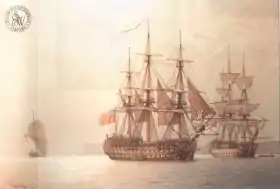HMS Glory (1788)
HMS Glory was a 98-gun second-rate ship of the line of the Royal Navy, launched on 5 July 1788 at Plymouth.
 HMS Glory (center) in company with HMS Valiant | |
| History | |
|---|---|
| Name | HMS Glory |
| Ordered | 16 July 1774 |
| Builder | Plymouth Dockyard |
| Laid down | 7 April 1775 |
| Launched | 5 July 1788 |
| Honours and awards |
|
| Fate | Broken up, 1825 |
| General characteristics [1] | |
| Class and type | Duke-class ship of the line |
| Tons burthen | 194417⁄94 bm |
| Length |
|
| Beam | 50 ft 1+3⁄8 in (15.3 m) |
| Depth of hold | 21 ft 2 in (6.45 m) |
| Propulsion | Sails |
| Sail plan | Full-rigged ship |
| Armament | |
History
In 1798, some of her crew were court-martialed for mutiny.[2]
Glory served as the flagship of Rear-Admiral Sir Charles Stirling at the Battle of Cape Finisterre in 1805, commanded by Captain Samuel Warren.
Glory was re-rated as a prison ship at Chatham on 27 September 1809. Lieutenant Richard Simmonds commanded her in 1810 and 1811.[1][Note 1] His replacement was Lieutenant Robert Tyte and Vice Admiral George Murray in 1794.[1]
Notes
- In 1812 Simmonds assumed command of the gunbrig HMS Attack.[3]
Citations
- Winfield (2008), p. 21.
- MacDougall, Phillip (2022). "The Naval Mutinies of 1798". The Mariner's Mirror. Society for Nautical Research. 108 (4): 423–428.
- Winfield (2008), p. 339.
References
This article is issued from Wikipedia. The text is licensed under Creative Commons - Attribution - Sharealike. Additional terms may apply for the media files.